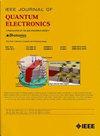Intradot Relaxation of Carriers and Modulation Bandwidth in Quantum Dot Lasers With Double Asymmetric Barrier Layers
IF 2.1
3区 工程技术
Q3 ENGINEERING, ELECTRICAL & ELECTRONIC
引用次数: 0
Abstract
Electron-hole recombination outside of a quantum-confined active region presents a major challenge in conventional injection lasers. Double asymmetric barrier layers (DABLs) flanking the active region should efficiently suppress this parasitic recombination. One of the challenges still remaining in DABL lasers is the presence of excited states in the active region. In this work, the impact of such states in quantum dots (QDs) on static and dynamic characteristics of DABL QD lasers is examined. The most dramatic case is considered where carriers can only be captured into the QD excited state before decaying to the ground state and thus contributing to lasing. We show that there exist optimum values for the DC component of the injection current, QD surface density, and cavity length that maximize the laser modulation bandwidth. The maximum bandwidth itself is strongly controlled by intradot relaxation of carriers—while it remains almost unchanged at the excited-to-ground state relaxation times shorter than 0.01 ps, it drops considerably for longer relaxation times in the considered structures. A strict control of the parameters is thus essential in DABL QD lasers to increase their modulation bandwidth.双非对称势垒层量子点激光器载流子的点内弛豫和调制带宽
在量子受限有源区外的电子-空穴复合是传统注入激光器面临的主要挑战。双不对称势垒层(DABLs)在活性区两侧可以有效地抑制这种寄生重组。在DABL激光器仍然存在的挑战之一是激发态在有源区域的存在。在这项工作中,研究了量子点(QDs)中的这些状态对DABL QD激光器静态和动态特性的影响。考虑了最戏剧性的情况,载流子只能在衰减到基态之前被捕获到QD激发态,从而有助于激光。结果表明,注入电流的直流分量、量子点表面密度和腔长都存在使激光调制带宽最大化的最佳值。最大带宽本身受到载流子的点内弛豫的强烈控制——虽然它在激发态到基态的弛豫时间小于0.01 ps时几乎保持不变,但在考虑的结构中,当弛豫时间较长时,它会显著下降。因此,在DABL QD激光器中,严格控制参数以增加其调制带宽是必不可少的。
本文章由计算机程序翻译,如有差异,请以英文原文为准。
求助全文
约1分钟内获得全文
求助全文
来源期刊

IEEE Journal of Quantum Electronics
工程技术-工程:电子与电气
CiteScore
4.70
自引率
4.00%
发文量
99
审稿时长
3.0 months
期刊介绍:
The IEEE Journal of Quantum Electronics is dedicated to the publication of manuscripts reporting novel experimental or theoretical results in the broad field of the science and technology of quantum electronics. The Journal comprises original contributions, both regular papers and letters, describing significant advances in the understanding of quantum electronics phenomena or the demonstration of new devices, systems, or applications. Manuscripts reporting new developments in systems and applications must emphasize quantum electronics principles or devices. The scope of JQE encompasses the generation, propagation, detection, and application of coherent electromagnetic radiation having wavelengths below one millimeter (i.e., in the submillimeter, infrared, visible, ultraviolet, etc., regions). Whether the focus of a manuscript is a quantum-electronic device or phenomenon, the critical factor in the editorial review of a manuscript is the potential impact of the results presented on continuing research in the field or on advancing the technological base of quantum electronics.
 求助内容:
求助内容: 应助结果提醒方式:
应助结果提醒方式:


